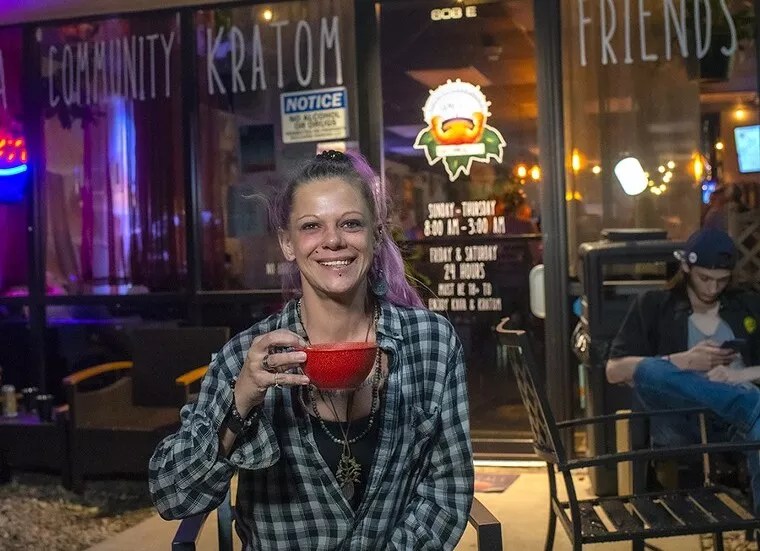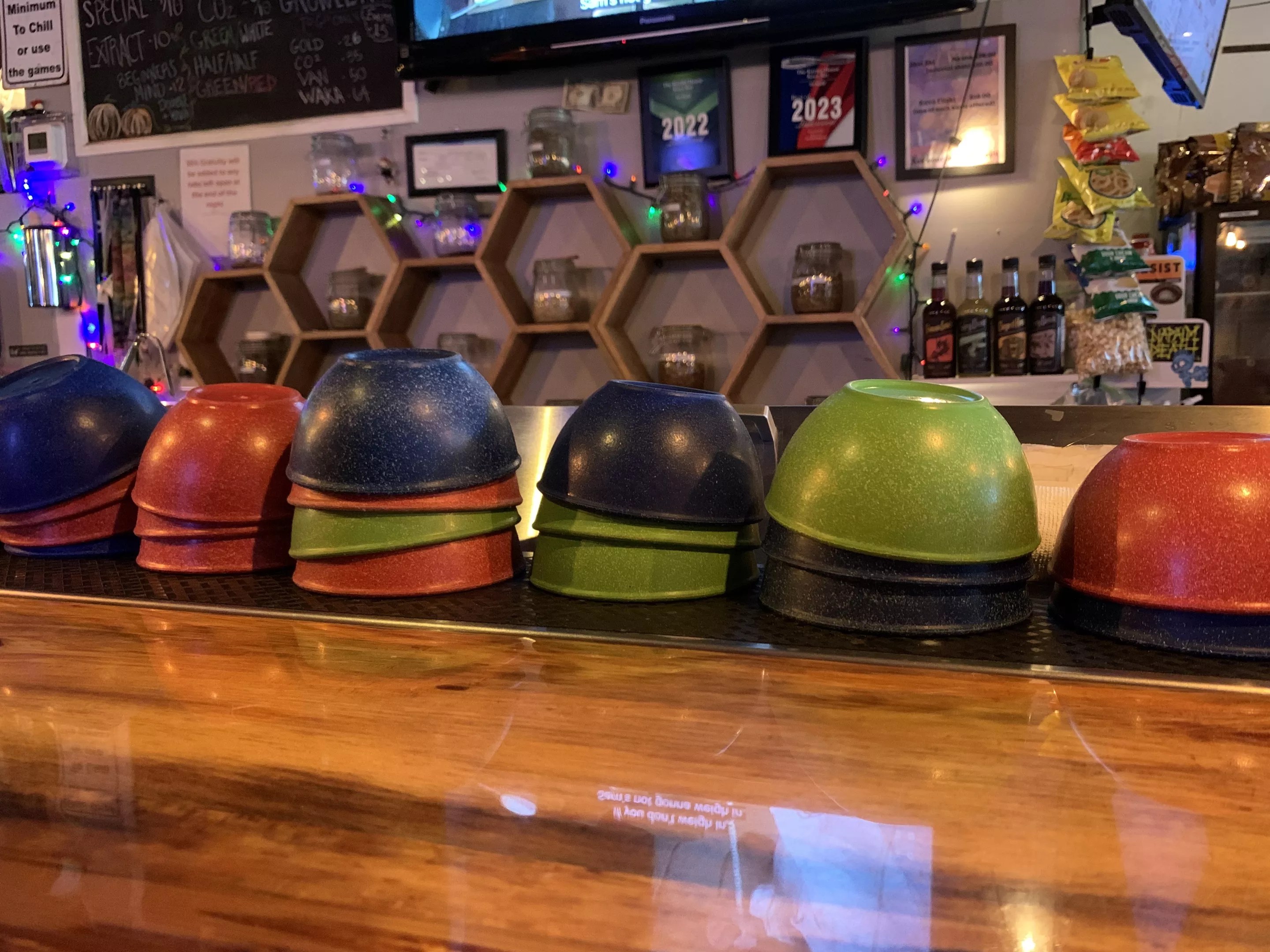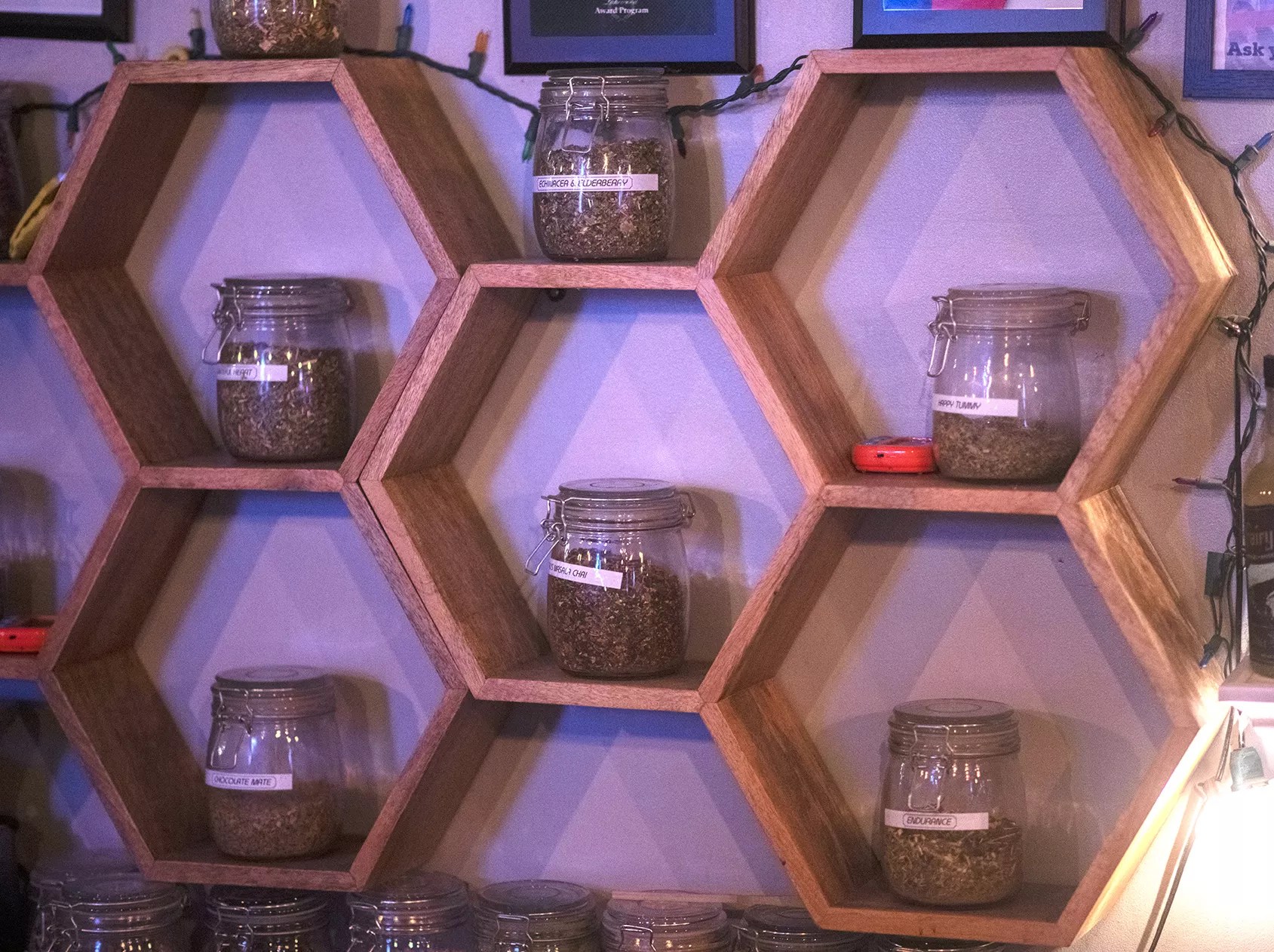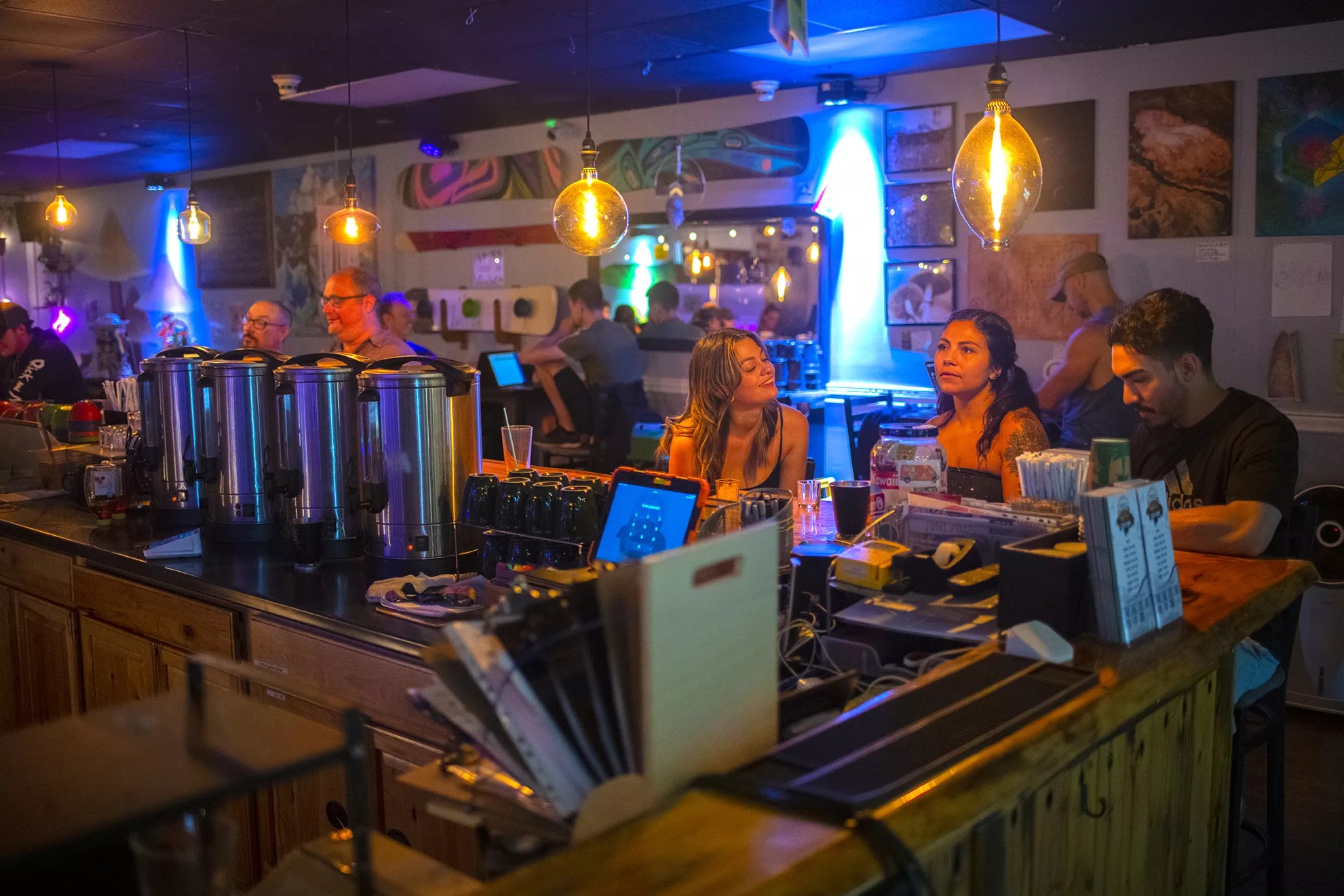
Evan Semón Photography

Audio By Carbonatix
At 5 p.m. on a spring Wednesday, all of the stools were already occupied by a kaleidoscope of characters. Most were self-acknowledged “crunchy hippies,” and more than one was barefoot. But then there were the two construction workers who’d just gotten off work, and right in the middle of the bar sat a guy who had his suit jacket off and the sleeves of his collared shirt rolled up, typing away at his laptop while sipping from his bowl.
Still, in this dimly lit space surrounded by people who were clearly regulars, I felt uneasy, and clutched at the pamphlet menu. “Uh…it’s my first time,” I blurted out to the bartender while apologetically elbowing aside the suited bro’s laptop to claim some bar space.
“Awesome!” she said kindly, and smiled. “First bowl of kava is on us.”
The guy on my other side turned, introduced himself, and encouraged me to also try the kratom. “I had it yesterday, and it was euphoric,” he proclaimed.
I was at the Karma House, a spot open since February 2021 in a Lakewood strip mall, and despite its similarities to a neighborhood dive bar, there was no alcohol on the menu. Instead, this bar serves kava and kratom teas – botanic psychoactives derived from plants native to the Asian Pacific islands. Reactions to the teas vary, but most people report feelings of relaxation and sleepiness with occasional instances of euphoria, as the friendly fellow on the next barstool had experienced. The teas are often marketed as a safer alternative to alcohol, since imbibers benefit from a social buzz but don’t lose motor or cognitive functions.
While kava and kratom have long histories of spiritual and/or recreational use in parts of Asia and the South Pacific, the first kava bar opened in Boca Raton, Florida, in 2000. Since then, kava bars have grown gradually but steadily in popularity – particularly in Colorado.
Kava, often described as “nature’s Xanax,” and kratom both have psychoactive properties. Currently, the federal government does not regulate either, leaving that up to individual states. As a result, kava bars (which generally serve kratom, too) have taken refuge in states with libertarian-leaning views toward mind-altering substances (see marijuana, mushrooms). Colorado is an obvious choice, contending for the title of “kava kapital” of the U.S., behind Florida (reigning champion), North Carolina and California.
Sam Monastra was running a kratom store in Ohio when he decided to leave that state’s precarious regulatory landscape and move to Colorado, where he opened Colorado Mountain Kava in downtown Longmont in October 2021. “Florida is the kava capital right now; they have about [75] kava bars,” he says. “But almost two years ago, when we opened, there were also about four other kava bars opening in Colorado at the same time. Colorado is supposed to be the next kava capital, and there’s supposed to be a lot of bars popping up in Colorado in the next few years.”
Pat Irvine, who started patronizing kava bars to help with his insomnia, opened The Root Kava in Boulder in 2018. “I was only the third kava bar in Colorado,” he recalls. “I’ve probably had three or four customers that were regulars that went on to open their own kava bars here in Colorado.” But despite the competition, he says he’s seen business triple.

Stacked bowls ready to be filled at the Karma House.
Helen Xu
The Science
Some bars refer to their kava and kratom products as “ethnobotanical tea”; ethnobotany is the study of how specific cultures and geographic areas utilize indigenous plants.
In Samoa, kava is used during tribal meetings to relax and encourage peaceful discussion among elders. “They take the root, they dry it out, they grind it up…then the ceremonial maiden will chew it, spit it into a kava bowl, mix it with a little bit of water,” says Paul Shankman, professor emeritus at the University of Colorado Boulder. “It’s served ceremonially inside a large, open house, and you have chiefs seated around the house in a ceremonial order, and the kava is served in order of the prestige of each chief. They will cheers to the gods, pour a little bit into the floor – which is made out of lava rock, so [the kava] goes right through the floor – and then drink from the cup.”
Shankman has participated in many kava ceremonies and even serves small cups of kava to students who take his South Pacific studies course. He’s never visited a kava bar, however. “I just can’t conceive of getting high at a bar on kava,” he says. “It’s just not something that kava has done to me, but maybe they’re serving it just so that people will mellow out rather than get stoned.”
As he describes kava’s effect, the “first thing that will happen is it will put your tongue to sleep, then your stomach to sleep, and then your legs to sleep. So it has an almost anesthetic kind of effect.”
It’s because of this calming effect that kava became popular with cab drivers across the South Pacific. According to Shankman, central cab stations often have large trash cans of brewed kava so that drivers can scoop out portions with their coffee mugs, then sit comfortably for hours on end. Thai and Malaysian farmers and laborers also rely on kava and kratom as pain relievers to help them get through grueling work days.
But today, kava and kratom are commonly used for recreational purposes throughout the Asian Pacific islands.
“A lot of people use it for anxiety…kava appeals to health-conscious people who maybe don’t like alcohol, or people getting sober from alcohol.”
“[Kava] just puts you in a better mood; you can still drive. It’s a good plant medicine for stress and relaxation,” Monastra explains. “A lot of people use it for anxiety…kava appeals to health-conscious people who maybe don’t like alcohol, or people getting sober from alcohol.”
“In a lower dosage of kratom, it acts as a stimulant,” adds Victor Boynton, bar manager at The Root. “At high dosages of kratom, it acts as a sedative; it’s going to be very relaxing, it’s going to be the best for pain relief, it’s going to be the best to help you get to sleep, and it’s going to be the best help with opiate withdrawal.”
Since kava bars often serve both kava and kratom, sometimes in the same drink, many customers may think they’re very similar. However, they have entirely different pharmacological profiles.
Kava is brewed from the root of a type of pepper plant and effectively acts as a central nervous depressant. According to Boynton, a self-taught kava and kratom biologist, the main active ingredients are kavalactones, which target the GABA receptors that interact with the limbic system to regulate emotions. These kavalactones also regulate dopamine in our bodies in a way similar to how selective serotonin reuptake inhibitors work, leading to a pleasant feeling when you’re drinking the brew. “There are no physical or chemical dependencies,” explains Boynton. “It does have a psychological dependency, but so does shopping.”
National Institutes of Health-sponsored studies confirm kava’s anxiety-reducing, calming effects. “Recent studies suggest that kava and its key phytochemicals have anti-inflammatory and anti-cancer effects, in addition to the well-documented neurological benefits. While its beneficial effects are widely recognized, rare hepatotoxicity had been associated with use of certain kava preparations, but there are no validations nor consistent mechanisms,” according to a report in the National Library of Medicine.
Other studies, however, mention the possibility of liver toxicity – though kava defenders say that such damage only occurs with excessive consumption.
“If you over-consume it, which takes a bit to do, then eventually your liver can be damaged, which honestly can be said for almost anything. You know, you drink too much soda, it’s going to damage your liver, and they don’t regulate that,” says Nick Gnieski, co-owner of the Karma House.
But regular consumers may not have to consume that much kava; there’s anecdotal evidence that it builds reverse tolerance in drinkers, meaning the more you drink, the sooner you’ll feel the effects. “I’m guessing there’s a small buildup,” says Boynton. “They need some time to build up beneficial compounds in your body, and then your body sort of knows what to do with them. It has enough of them in there, and so wherever you start adding more, consuming more of the plant, it starts to have a heavier effect on you.”
Kratom, on the other hand, has opiate-like qualities, making it potentially addictive. It’s brewed from the leaves of the evergreen plant and contains alkaloids that interact with opioid receptors in the brain, which modulate how we respond to pain. There has been significantly less research regarding kratom than there has been for kava, but it’s widely accepted that the two main psychoactive ingredients are alkaloids mitragynine and 7-hydroxymitragynine.
Kratom has effects similar to those of morphine and opiates, but Boynton notes differences. “They only partially activate the opiate receptors,” he says. “They don’t activate something called the beta-arrestin pathway, which is responsible for the respiratory depression and constipation and sedation that you get from normal opiates.
“And while kratom is addictive, it’s not the most addictive thing in the world. I’d say that caffeine is more addictive than kratom is.”

Bartenders serve drinks with kava and kratom, not drinks, at the Karma House.
Evan Semón
The Business
Metro Denver’s kava scene is still small enough to be a community. With the exception of Kavasutra, a kava bar chain with 25 locations across the U.S. that’s owned by Palm Beach entrepreneur Dylan Harrison, all the kava bars here are independently owned, and the owners all know each other.
In large part, members of the kava community have been able to hold each other accountable – endorsing the community spirit of kava, offering the traditional preparation of the teas as the main product, and taking on the responsibility of looking out for their patrons. But so do their regulars, who are generally helpful with first-timers, offering advice and cautions.
It’s a scene that draws people who would normally shy away from hanging out at bars and clubs. “It’s nice to have an environment where I can be social, relax and enjoy myself without getting intoxicated or having any repercussions, and be around like-minded people who want to stay away from alcohol and drugs,” says Gnieski.
In keeping with the community vibe, Gnieski keeps the Karma House open from 8 a.m. to 3 a.m. Monday through Thursday and then 24/7 throughout the weekend. During the day, the vibe is similar to that of a coffee shop, with people working away on their laptops and students buried in their textbooks. Then around 7 p.m., the crowd swells, becoming more social and chatty. Some nights, a dance floor appears.
“If you were to come to a kava bar two or three days in a row, you’d see a lot of the same people. There’s a strong community; it’s a hangout spot for people,” says Irvine. “Usually when people come here for the first time, especially college students, they find that it’s a place that it’s easy to make friends. It’s like a safe zone for a lot of people.”
“They find that it’s a place that it’s easy to make friends. It’s like a safe zone for a lot of people.”
While a large percentage of patrons could be mistaken for stoner types, Irvin disputes that label. “I would say only a small percentage of people that come to [The Root Kava] actually smoke marijuana as well. You see people from all walks of life in here. You see students, the elderly, you see working professionals,” he notes. “You see athletes – athletes are starting to learn a lot more about kava because of the anti-inflammatory effects, and also it helps with muscle recovery – and I’ve seen military people out in kava bars, so it doesn’t really attract just the stoner crowd.”
While kava bars are billed as an alternative to bars that serve alcohol, they sometimes feel actively anti-alcohol. Patrons often are recovering alcoholics – or their partners are, and they want to avoid traditional bars.
None of Colorado’s kava bars serve alcohol, and many bar owners adamantly refuse to even entertain the idea. “I would never own a regular bar – not in a million years,” says Irvine. “It’s not that I personally have anything against alcohol; it’s just that I don’t want the issues that come along with alcohol. In the five years that I’ve been open, I’ve never had a single physical altercation.”
However, even the most adamant kava/kratom defenders concede that there are overconsumption risks that simply don’t exist at coffee shops. “Every kava bar has experienced someone throwing up at least once,” says Monastra. “With kava and kratom, you can overdo it. It’s just a bit different from alcohol, though, because you never lose your sense of self. You can definitely push it too far and it would result in getting sick or throwing up. Especially for new people, we really try to look out for them and let them know what they’re getting into.”
But not every bar owner displays the same sense of responsibility, and as kava bars become increasingly popular, it’s inevitable that some enterprising capitalists will view the community as a consumer base -riding the sober-trend wave and pushing the boundaries. The Florida scene is full of such outfits, with full-on tiki decor and selling multi-colored unicorn kava cocktails covered in whipped cream at bars with DJ sets and wet T-shirt contests.
“We don’t do that. We like to serve kava traditionally, in a shell, keeping kava as traditional as possible,” says Irvine. “I’ve seen at some kava bars in Florida where they have kava drinking contests, and I’m not for that.”
“Kava comes from the South Pacific, and there’s a way to prepare kava that is traditional and, in my opinion, the right way to do it,” Gnieski says. “And then there are kava bars that open up and see dollar signs, and they’re like, ‘Hey, you know, there’s a big markup from the product. Let’s get as much money as possible.'”

Kava options on display.
Evan Semón
The Regulations
Nationally, kava is considered a food supplement and falls under the purview of the Food and Drug Administration, which has taken a hands-off, conservative approach to regulating it. The agency last discussed kava in March 2002, when it issued an advisory warning consumers and health-care professionals of the risk of liver damage.
The Denver Department of Public Health & Environment started paying attention to kava as kava bars began opening: Kavasutra, Mad Hatter’s and Twisted Root. In August 2019, the DDPHE issued a letter to these businesses stating, “The FDA considers kava to be a supplement that is limited to personal use. Kava is not Generally Recognized As Safe (GRAS) according to 21 CFR Part 170.30 and, therefore, as with any supplement that is not GRAS, cannot be used in foods or beverages as an ingredient.”
Both Mad Hatter’s and Twisted Root have since shut down, leaving just one kava bar within Denver city limits: Kavasutra, which provides customers individually sealed packages of kava and hot water to mix themselves. According to Amber Campbell, DDPHE spokesperson, this presentation “would not be considered a regulated food product and wouldn’t require a retail food license.”
In the surrounding cities, there are few restrictions on kava bars. “We’re a teahouse, technically, so we just have a beverage license, no food license,” explains Monastra.
“Kava is harmless…it’s a body and mind relaxant, which is great for stress. It’s an alcohol alternative, which is phenomenal. People will drink kava instead of alcohol, which kava is much less dangerous than alcohol,” says Gnieski.
The same is not true of kratom. “There are no FDA-approved uses for kratom, and the agency has received concerning reports about the safety of kratom. FDA is actively evaluating all available scientific information on this issue and continues to warn consumers not to use any products labeled as containing the botanical substance kratom or its psychoactive compounds, mitragynine and 7-hydroxymitragynine,” says a statement put out by the FDA.
In 2012 and 2014, the FDA issued import alerts for kratom products packaged as drugs and dietary supplements, labeling them as unapproved uses and seizing millions of dollars’ worth of product coming in through American ports.
The Drug Enforcement Administration flirted with classifying kratom as a Schedule I drug in August 2016. But after community backlash and an extended “listening period,” the proposed initiative was quietly dropped.
In the silence that followed, some states stepped in. Kratom is now illegal in Alabama, Arkansas, Indiana, Rhode Island, Tennessee, Vermont, Wisconsin and in select cities/counties of California, Florida, Illinois, Mississippi and New Hampshire. But Arizona, Georgia, Nevada and Utah have all passed the Kratom Consumer Protection ACT, which legalizes kratom but sets certain requirements such as those concerning minimum age and testing.
In its 2022 session, the Colorado Legislature passed SB22-120, Regulation of Kratom Processors. Scheduled to go into effect on July 1, 2024, SB22-120 dictates that kratom sellers cannot adulterate kratom with fentanyl or other controlled substances, and must make all reasonable effort to not sell to anyone under the age of 21. “We expect that any enforcement of the provisions in SB22-120 will be driven by local law enforcement (and potentially, local health agencies in jurisdictions that permit the manufacture or sale of kratom products),” says Daniel Carr, director of communications for the Colorado Department of Revenue.
Although that agency was not given regulatory power by the bill, that could change. SB22-120 also commissioned a report by the Department of Revenue evaluating further regulation standards around kratom. Two of the bill’s sponsors, senators Joann Ginal and Tom Sullivan, then followed up with SB23-147, Regulation of Kratom in the most recent session; the proposal included many of the recommendations outlined in the initial report. It would have extended regulation by requiring kratom processors to register with the Department of Revenue, report any adverse events to the FDA, and pay to test its products in a third-party laboratory. But consideration of that bill was postponed indefinitely.
“It’s kind of like how the weed industry was when it was first emerging. There’s yet to be quality control, regulations, etc.”
In the absence of more government regulation, the kava community is coming up with its own guidelines. “It’s kind of like how the weed industry was when it was first emerging. There’s yet to be quality control, regulations, etc. Which all of us kratom users, trade stores and kava bars, we all want the regulations to come because it’ll just [legitimize] the bars and stores and people using it,” Monastra says. “There’s just not enough regulation right now.”
Irvine would like to see regulations around sourcing and testing. “We direct-source from the Tonga Islands, so we have a partnership with this family over in Tonga. When it leaves the island there, it actually goes through New Zealand University and it’s tested, and then it’s shipped to us directly to DIA,” he says. “So for anybody who sells kratom, they should probably have to show where they source it from, where it was tested.”
Irvine also pushes for the customer and seller sharing responsibility. “If a customer is going into any place, anything they’re going to ingest, they should probably ask some questions, especially when it comes to something different like kava or kratom,” he says.
“There weren’t a whole lot of regulations put on us when we started, and honestly, there’s still not. It’s hard for me to say, because I just naturally do the right thing…and as far as I’ve seen, everybody’s who’s been starting up kava bars has been doing a good job,” says Gnieski. “I think the strongest point I would have on the subject would be to push for education, not regulations.”

Both regulars and the kava-curious come to the Karma House.
Evan Semón
The Way Forward
My first experience with kava was similar to my amateur attempts with alcohol and marijuana in college. First, it tasted disgusting, and ordering the lemonade version didn’t help. It was like drinking a dirty herbal root, though the regulars assured me the taste would become more pleasant with time. Second, the majority of my stint at the bar was not spent relaxing, but rather turning to my drinking companion every thirty seconds and aggressively asking, “Are you feeling anything? Anything?”
While I doubt I’ll become a regular consumer of kava or kratom, more and more Denver residents are. And for Monastra, Boynton, Irvine and Gnieski, their businesses will depend not only on this clientele, but on the continued accessibility of both kava and kratom.
For now, their focus remains fixed on the present, supporting and improving the community in which they are pillars – providing safe spaces and social places where anyone is welcome to walk in, order a bowl and sip away.